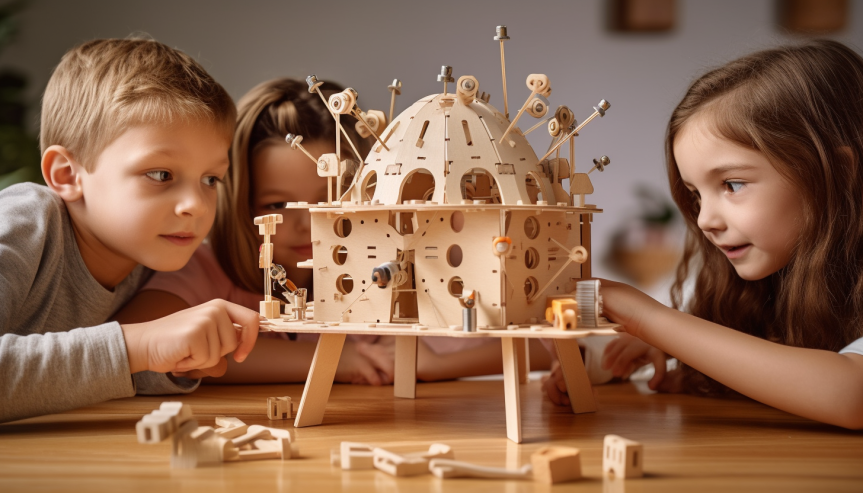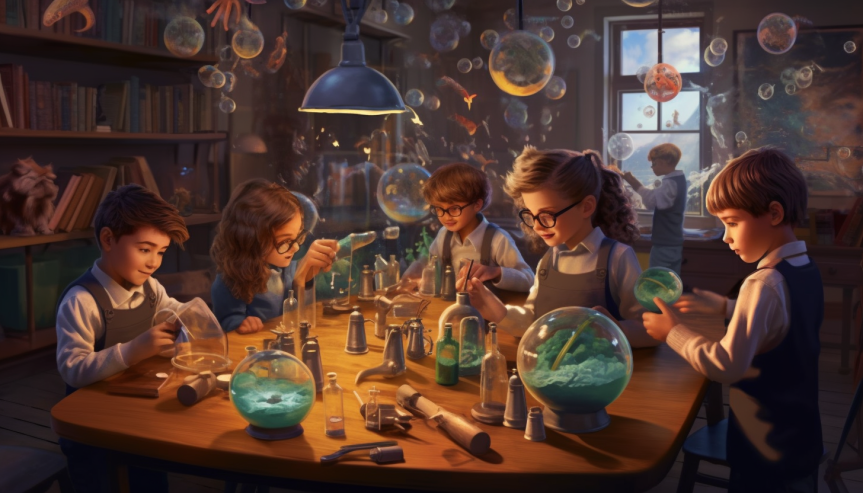50 Fun and Educational STEM Science Projects for Kids
Featuring a comprehensive roundup of 50 STEM Science Projects for kids from constructing simple machines to exploring the basics of coding, these projects promise to make learning an exciting and hands-on experience for kids of all ages.

Imagine a world where learning is an adventure, where curiosity is ignited, and where young minds are empowered through hands-on exploration of science, technology, engineering, and math (STEM). Welcome to the world of “50 Fun and Educational STEM Science Projects for Kids!” This blog post is designed to be a treasure trove of activities that combine STEM concepts with art, providing a well-rounded learning experience for kids of all ages.
Key Takeaways
- Explore and discover the wonders of STEM through exciting science experiments!
- Develop problem-solving skills, creativity & critical thinking with hands-on engineering projects.
- Inspire a lifelong love for math & art by combining them into fun activities.
Exploring STEM Through Science Experiments

Do you remember the sense of wonder you felt when witnessing a chemical reaction, or the thrill of understanding the world around you through hands-on experiments? Children can rekindle that same excitement, curiosity, and imagination by delving into STEM via science experiments.
From colorful chemistry wonders to physics fun, these activities provide the perfect foundation for young scientists.
Chemistry Wonders
Who knew that mixing just a few ingredients, like baking soda, could create such awe-inspiring results? Children can delve into the fascinating realm of chemical reactions and substance properties through Chemistry wonders. Activities like:
- Food Chemistry Experiment
- Lemon Battery Experiment
- Dirt Battery Experiment
- Elephant Toothpaste Experiment
Not only do these activities engage children in hands-on learning, but they also provide a colorful and vibrant experience that is so much fun, leaving them wanting more.
And who could forget the magic of Coffee-Filter Chromatography? Uncovering the mysteries of color composition is both educational and artistic, proving that chemistry can be a visual treat as well. With just a few drops, and so many exciting experiments to choose from, your little chemists are bound to be captivated by the wonders of chemistry. There're endless possibilities to make a chemistry experiment with just household items or subscribe to a chemistry kit like MEL Science.
Physics Fun
Beyond equations and formulas, Physics also encompasses the engaging exploration of forces, motion, and energy. The Cloud in a Bottle experiment allows students to witness the fascinating process of water condensation, while the Solar Powered Lego Car and Balloon Powered Car experiments combine ingenuity and engineering with the power of the sun and air pressure, respectively.
Another fan favorite among young physicists is the Marble Maze challenge. Using straws, paper plates, and other materials, children can design their very own marble mazes, testing their STEM skills and creativity in the process. Physics fun provides endless possibilities for hands-on learning and exploration, sparking a lifelong love for this branch of science.
Engineering Skills Through Hands-On Projects

Engineering is all about designing, building, and testing creations to solve real-world problems. These practical projects not only enhance children’s engineering skills, but also cultivate their creativity and critical thinking abilities.
Children have endless opportunities to exercise their engineering skills through activities ranging from bridge construction to designing functional objects and crafting machines.
Building Bridges
Bridges are an integral part of our world, and learning how to build them provides a fantastic opportunity for kids to explore engineering concepts. Using various materials and techniques, children can construct bridges and test their strength and stability.
This hands-on project challenges kids to think creatively and problem-solve, all while learning about the importance of strong and stable structures.
Designing Functional Objects
What do cell phone stands and water filters have in common? They’re both examples of functional objects that can be designed and built by young engineers. Encouraging creativity and problem-solving, these projects, like creating a cell phone stand, allow kids to apply engineering principles to everyday objects, making learning not only fun but also practical.
Using resources like Science Buddies/Engineer, students can find guidance on building their very own functional objects, combining engineering skills with real-world applications.
Crafting Machines
Simple machines and devices, such as catapults and roller coasters, provide an exciting way for kids to delve into the world of mechanics and engineering principles. Building these machines from scratch offers a hands-on learning experience and a chance to explore the design process. Children can also see the fruits of their labor by testing their creations and observing their functionality.
The Marble Speed Trap project is an excellent example of how physics and engineering can be combined to create a fun and engaging learning experience. By designing and building their very own marble speed trap using Legos, students can explore the concept of velocity in a hands-on and interactive manner.
Math Activities That Inspire Learning

Mathematics is often seen as a daunting subject, but it doesn’t have to be! Inspiring math activities that promote learning and exploration can cultivate a love for this crucial discipline among children.
From measuring and comparing objects to exploring patterns and sequences, these activities provide a fun and interactive way for children to hone their math skills.
Measuring and Comparing
Measurement, fractions, and ratios are fundamental math concepts that can be explored using everyday objects. Activities such as scavenger hunts for objects of specific measurements or estimating the circumference of an apple help children grasp these concepts in a tangible and enjoyable manner.
By incorporating real-life scenarios and hands-on activities, kids can develop a strong foundation in math while having fun.
Exploring Patterns and Sequences
Patterns and sequences are everywhere, from nature to art and even numbers. Investigating these fascinating phenomena helps children develop their analytical and problem-solving skills.
Activities that explore the Fibonacci sequence, the Golden Ratio, and the spiral pattern of a sunflower can ignite curiosity and foster a love for math, showing kids that mathematics can be both beautiful and captivating.
Problem Solving Challenges
Real-world problems require critical thinking, and math is an essential tool for solving them. Engaging in problem-solving challenges allows children to apply their math skills to a variety of situations, honing their analytical abilities and fostering creativity.
From designing a bridge to finding the most efficient route for a delivery, problem-solving challenges offer endless opportunities for kids to put their math skills to the test.
Combining Art and STEM

Art and STEM may seem like two completely different worlds, but they can actually work together in harmony to create a well-rounded learning experience. By incorporating the concept of “combine art” into STEM activities, children can delve into scientific concepts in a more engaging and creative way.
From colorful chemistry experiments to designing functional objects with an artistic twist, the combination of art and STEM offers endless opportunities for discovery and learning.
Colorful Chemistry
Who says chemistry has to be dull and colorless? Colorful chemistry activities, such as the Magic Milk Experiment, Density Lava Lamps, and Color Mixing, allow children to create vibrant art pieces while learning about chemical reactions and color mixing. These eye-catching experiments can help children develop an appreciation for both science and art, demonstrating that chemistry can be both educational and visually appealing.
Another exciting example of colorful chemistry is the Blooming Paper Flowers Experiment. By observing how water absorption affects paper, children can witness the captivating process of paper flowers “blooming” before their eyes. This experiment not only teaches kids about the science behind water absorption, but also allows them to create beautiful art pieces in the process.
Sculpting Structures
Exploring engineering concepts doesn’t have to be limited to traditional materials. Sculpting structures using unconventional materials, such as sugar cubes or egg cartons, can provide a fresh perspective on engineering while encouraging creativity and problem-solving.
These unique building materials can inspire kids to think outside the box and develop innovative solutions to engineering challenges, all while creating stunning structures that showcase their artistic talents.
Designing for Function

Encouraging creativity and problem-solving in kids is essential for their development, and designing functional objects with an artistic twist provides the perfect opportunity for them to flex their creative muscles. By combining engineering principles with artistic flair, children can create objects that are both functional and visually appealing.
This fusion of art and STEM not only fosters critical thinking but also helps children develop a greater appreciation for the beauty and functionality of the world around them.
STEM Activities for Different Age Groups

As unique as each child, STEM activities are tailored to cater to their distinct needs and interests. From preschoolers to middle schoolers, there are a wealth of age-appropriate stem activity options that can inspire curiosity and learning.
By tailoring these activities to different age groups, including younger kids, we can ensure that kids have the opportunity to explore STEM concepts at a level that is both challenging and engaging.
Preschool STEM Fun
Introducing STEM concepts to young learners can be both fun and educational. Preschool STEM fun involves engaging in simple, hands-on activities that allow children to explore basic concepts and gain an understanding of cause and effect relationships.
Activities like building an apple boat, constructing a toothpick-marshmallow castle, or trying a pom-pom drop can provide hours of entertainment and learning for your little scientists.
Elementary School Exploration
Elementary school students are ready to take their STEM learning to the next level. With age-appropriate STEM projects, they can explore:
- Coding
- Robotics
- Engineering challenges
- Scientific investigations
These projects build on foundational skills and provide students with hands-on learning experiences.
These exciting activities not only further their understanding of STEM concepts, but also help them develop a greater appreciation for the world around them.
Middle School Challenges
As children progress to middle school, their STEM activities can become more advanced and complex. Middle school stem challenge encourages critical thinking and problem-solving with activities such as:
- Coding
- Robotics
- Engineering challenges
- Scientific investigations
Older students may even have the opportunity to pursue independent research projects and collaborate with professionals in the field, providing them with invaluable real-world experience.
Adapting STEM Projects for the Classroom

STEM projects, adaptable for the classroom setting, offer a plethora of opportunities for group collaborations, individual exploration, and cross-curricular links. By incorporating a stem project into lesson plans, teachers can engage students in meaningful learning experiences that foster the development of valuable STEM skills.
From coding challenges to constructing structures with recycled materials, the possibilities are endless when it comes to adapting STEM projects, including science projects, for the classroom.
Resources for Further STEM Exploration
Numerous resources are available to support your journey if you aim to delve further into the STEM world. Websites like Khan Academy, Code.org, and Scratch offer a wealth of information and activities for students of all ages. Books such as “The Magic School Bus” series, “The Way Things Work” series, and “The Science of Everything” series can ignite curiosity and provide a solid foundation for further exploration.
Additionally, community programs like Girls Who Code, FIRST Robotics, and Science Olympiad offer opportunities for hands-on learning and collaboration, fostering a lifelong love for STEM.
Summary
As we’ve explored throughout this blog post, STEM activities provide an engaging and exciting way for children to learn and grow. By combining science, technology, engineering, and math with art, we can create a well-rounded learning experience that fosters curiosity, creativity, and critical thinking. Whether you’re a parent, teacher, or simply someone who loves to learn, these “50 Fun and Educational STEM Science Projects for Kids” offer a wealth of opportunities for hands-on exploration and discovery. So, what are you waiting for? Dive in and ignite your child’s passion for STEM today!
Frequently Asked Questions
What is a STEM science project?
STEM stands for science, technology, engineering and math, so a STEM project will intertwine two or more of these areas to solve a problem and focus on real-world applications.
STEM projects are designed to be hands-on and engaging, encouraging students to think critically and apply their knowledge to solve real-world problems. They can also help students develop skills such as problem-solving, collaboration, and communication.
What are some examples of STEM projects?
STEM projects can include creating a water filter, growing a plant with different liquids, determining the best way to melt ice, making a fire snake, an Alka Seltzer powered lava lamp, a harmonica, balloon or wind-powered cars, rubber band cars, straw skyscrapers, candy gears, toothpick bridges, edible DNA, and DIY marble runs.
Kids can also enjoy STEM activities such as cloud in a jar, oil spills, sticky note number match, coding a LEGO® maze, crystal sun catchers, building a hand crank winch, build a balance scale, and magnetic slime.
How can I adapt STEM projects for the classroom?
Motivate your students with hands-on STEM projects that involve individual exploration and group work. Tap into the power of cross-curricular connections to make STEM engaging and meaningful for your class.
What resources are available for further STEM exploration?
There are plenty of resources available to further explore STEM, such as websites, books, and community programs.
All of these provide valuable information and activities for students of all ages.
How can I combine art and STEM for a well-rounded learning experience?
Motivate your learning experience with a combination of art and STEM - try out colorful chemistry experiments or design functional objects with an artistic twist!
Combining art and STEM can be a great way to make learning more engaging and enjoyable. Chemistry experiments can be made more interesting with the use of color, and functional objects can be designed with an artistic flair. This can help to save money.

